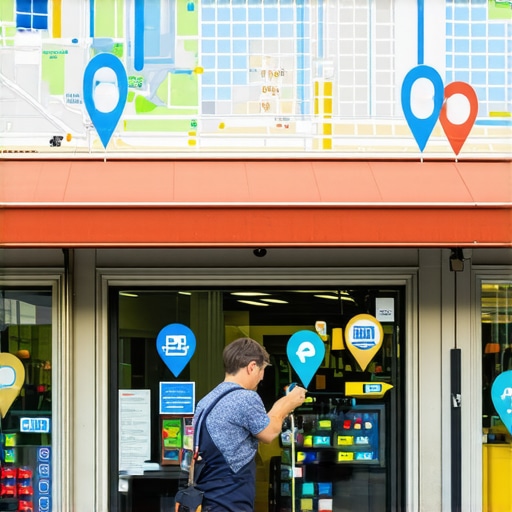
Effective Signal Repair Tricks to Boost GMB Local Rankings in 2024
My Journey into Signal Repair and Local SEO Success
Not long ago, I found myself struggling with my Google My Business (GMB) rankings. Despite putting in effort, my local visibility was stagnating. It was frustrating, but it also became a turning point. I started exploring effective signal repair tricks, which I now realize are essential for boosting local rankings in 2024. Sharing my experience might help you navigate similar challenges.
Understanding the Power of Signal Repair in GMB Optimization
In my early days, I underestimated the importance of maintaining clean and accurate signals for my GMB listing. After reading authoritative sources like this guide, I learned that consistent signals—like NAP consistency, review signals, and category accuracy—are vital. These signals act as trust indicators to Google, telling it that my business is legitimate and relevant.
My Favorite Signal Repair Tricks That Actually Work
One trick I found invaluable was conducting regular GMB cleanup sessions. This involved removing duplicate listings, updating outdated information, and ensuring my business details matched across all platforms. I also focused heavily on resolving negative reviews and encouraging genuine positive feedback, which significantly impacted my rankings. These steps are aligned with what experts recommend for effective GMB signal repair.
Deeper Insights: Why Do Some Signal Repairs Fail?
What are the common pitfalls that hinder successful signal repair?
From my experience, one common mistake is neglecting to verify the consistency of your business information across all online directories. Inconsistent NAP details can confuse Google and weaken your signals. Additionally, ignoring negative reviews or spammy backlinks can undermine your efforts. For comprehensive strategies, I recommend exploring this resource for advanced cleanup techniques.
If you’re serious about boosting your local rankings, I encourage you to dive deep into signal repair practices. They may seem technical at first, but with patience and consistency, they can transform your GMB presence.
Do you have your own signal repair tips or success stories? I’d love to hear your experiences—drop a comment below and let’s learn from each other!
Unlocking the Full Potential of Signal Repair: An Expert’s Deep Dive
As I continued refining my GMB cleanup techniques, I discovered that understanding the nuanced mechanics behind signal repair is crucial. Simply updating NAP details or responding to reviews isn’t enough; the process demands a strategic, layered approach. For instance, aligning your business information across all platforms with precision ensures that Google perceives your signals as consistent and trustworthy. This consistency directly influences your position in local map packs, especially when competitive niches are involved.
How Can Advanced Signal Repair Techniques Elevate Your Local SEO Game?
Beyond basic cleanup, advanced strategies involve leveraging data-driven insights. Using tools that analyze your existing signals can reveal hidden inconsistencies or spammy backlinks that undermine your authority. Additionally, implementing schema markup on your website to reinforce your GMB information can strengthen your signals. These methods, when combined with regular reviews and profile updates, create a resilient ecosystem that Google trusts, boosting your rankings significantly. For a comprehensive guide, consider exploring this resource.
Are You Overlooking the Power of Authentic Engagement in Signal Repair?
Authentic engagement, such as encouraging real customer reviews and responding thoughtfully, plays a pivotal role in signal strength. Negative reviews, if left unaddressed, can weaken your profile and diminish your local visibility. Conversely, genuine positive interactions serve as social proof, reinforcing your business’s credibility. This human element, combined with technical cleanup, forms a holistic approach to signal repair that aligns with Google’s evolving algorithms. For more detailed tactics, visit this guide.
If you’re eager to elevate your local rankings, I invite you to share your experiences or ask questions below. Also, check out our related articles to deepen your understanding of GMB optimization strategies.
Unraveling the Complexity of Signal Repair: Beyond Basic Fixes
As I’ve delved deeper into the world of GMB optimization, I’ve realized that successful signal repair isn’t just about ticking boxes or making superficial updates. It’s about understanding the intricate web of trust signals that Google relies on to assess your business. For instance, ensuring your NAP consistency isn’t just a matter of matching addresses—it’s about verifying that every mention, review, and citation aligns perfectly across hundreds of directories and platforms. This level of precision can be daunting, but it’s crucial for outsmarting competitors who might overlook these details.
Why Do Some Signal Repairs Fail Despite Efforts?
What are the hidden pitfalls that can sabotage even the most meticulous signal repair efforts?
In my experience, one often-overlooked factor is the presence of spammy backlinks or fake reviews that can cast doubt on your legitimacy. Google’s algorithms are increasingly sophisticated at detecting unnatural patterns. Therefore, a comprehensive cleanup must include not only your GMB profile but also your website’s backlink profile. Tools like this resource have helped me identify and disavow harmful links, restoring trustworthiness to my signals.
Additionally, I’ve learned that inconsistent schema markup or outdated website data can create conflicting signals, confusing Google and undermining your rankings. Regularly auditing your digital presence ensures your signals are harmonized across all touchpoints.
Deepening Engagement: The Human Element in Signal Strength
One of the most powerful yet underrated aspects of signal repair is authentic engagement. Genuine reviews and thoughtful responses can significantly influence your perceived credibility. I’ve seen firsthand how addressing negative reviews professionally not only mitigates their damage but also demonstrates your commitment to customer satisfaction, which Google interprets favorably. This human touch creates a positive feedback loop—improving signals and reinforcing trust.
Moreover, encouraging real customers to share their experiences through follow-up emails or social media outreach can generate fresh, positive signals that boost your profile’s authority. It’s a continuous process that, when done authentically, pays dividends in local rankings.
Harnessing Data-Driven Insights for Advanced Signal Optimization
To truly elevate my local SEO game, I started leveraging analytics tools that track signal consistency and detect anomalies. For example, analyzing citation patterns and review trends helped me identify spikes in spam or inconsistencies that required immediate attention. Implementing schema markup on my website further reinforced my GMB signals, creating a layered, robust presence that Google trusted.
This approach is akin to building a fortress—each layer of trust signals fortifies your position in the local map pack. If you’re interested in exploring these strategies, I recommend reviewing this comprehensive guide.
Inviting Your Experience: Share Your Signal Repair Journey
Finally, I believe that learning from each other’s experiences is invaluable. Have you encountered unique challenges or innovative solutions in your signal repair efforts? I’d love to hear your stories—drop a comment below or connect with me on social media. Together, we can navigate the complexities of local SEO and unlock new heights of visibility.
Decoding the Subtle Art of Signal Harmonization for GMB Triumphs
As I delved deeper into refining my GMB signal repair techniques, I realized that the true mastery lies in understanding the intricate web of trust signals that Google evaluates, especially in hyper-competitive markets. Beyond rectifying NAP inconsistencies or responding to reviews, the key is to orchestrate a symphony of aligned, authentic signals across every digital touchpoint. This involves meticulous audits of citation accuracy, structured data implementation, and consistent brand mentions, all working synergistically to reinforce your business’s legitimacy.
Why Do Sophisticated Signal Discrepancies Sabotage Your Efforts?
What hidden pitfalls can undermine even the most diligent signal repair campaigns?
One often overlooked factor is the presence of spammy backlinks or fabricated reviews that can erode trust in your online profile. Google’s algorithms have become adept at detecting unnatural link patterns and review anomalies, which can nullify your efforts. To combat this, I recommend leveraging advanced backlink analysis tools, such as this comprehensive resource, to identify and disavow harmful links effectively. Additionally, inconsistent schema markup or outdated website data can generate conflicting signals, confusing Google and diminishing your rankings. Regular, rigorous audits of your entire digital footprint are essential for maintaining signal integrity.

The Human Touch: Authentic Engagement as a Signal Amplifier
Authentic engagement, such as soliciting genuine reviews and responding with empathy and professionalism, has a profound impact on your signal strength. I’ve observed that addressing negative feedback transparently demonstrates your commitment to customer satisfaction, which Google perceives as a trust signal. Encouraging satisfied clients to share their experiences through personalized follow-ups or social media campaigns can generate fresh, positive signals that bolster your profile’s authority. This human element, combined with technical precision, creates a resilient ecosystem resistant to algorithmic fluctuations.
Harnessing Data and Schema for a Robust Signal Ecosystem
My approach evolved to include leveraging analytics to monitor citation consistency, review patterns, and backlink profiles. Implementing schema markup—particularly LocalBusiness schema—on my website helped reinforce my GMB signals, ensuring Google recognizes the connection between my website and my listing. These layered signals form a fortress of trust, elevating my local pack visibility. For those interested in implementing these strategies, I recommend exploring this detailed guide.
Engage and Share Your Signal Repair Wisdom
Finally, I invite you to reflect on your own experiences with signal repair. Have you uncovered unique challenges or innovative tactics that propelled your local rankings? Sharing your insights can inspire a collaborative learning environment. Drop a comment below or connect with me on social channels. Together, we can master the art of local SEO dominance, navigating the complexities with confidence and strategic finesse.
Things I Wish I Knew Earlier (or You Might Find Surprising)
The Power of Consistency
Early on, I underestimated how crucial it is to keep all your business information perfectly aligned across every platform. A small discrepancy in your NAP details can silently sabotage your local rankings. Once I started auditing my citations regularly, I saw visible improvements in my GMB visibility.
Negative Reviews Are Not the Enemy
At first, I thought negative reviews would harm my profile forever. But I learned that addressing them professionally and encouraging genuine positive feedback actually strengthened my signals. It’s about turning negatives into opportunities for trust-building.
The Importance of Clean Backlinks
Backlinks that seem harmless can sometimes be spammy or low-quality, and Google is smart enough to spot these. Disavowing harmful backlinks made a noticeable difference in how my signals were perceived by search engines.
Schema Markup Matters More Than I Thought
Adding detailed schema markup to my website created a layered trust signal that complemented my GMB profile. It’s like giving Google a detailed map of your business’s legitimacy.
Authentic Engagement Is a Signal Force Multiplier
Encouraging real customers to leave reviews and responding thoughtfully can significantly boost your profile’s credibility—more than just technical fixes alone.
Resources I’ve Come to Trust Over Time
- Google’s Official My Business Help Center: A must-visit for the latest guidelines and updates directly from Google, keeping my strategies aligned with their evolving algorithms.
- BrightLocal Blog: They offer practical insights and case studies that helped me understand local SEO nuances better.
- Moz Local Search Resources: Moz’s tools and guides have been invaluable in diagnosing and fixing local signal issues effectively.
- GMBexorcist: Specifically focused on GMB signal repair techniques, it’s my go-to for advanced strategies and troubleshooting.
Parting Thoughts from My Perspective
If there’s one thing I’ve learned about boosting local rankings in 2024, it’s that signal repair is both an art and a science. It requires meticulous attention to detail, genuine engagement, and strategic use of tools and resources. The journey might seem overwhelming at first, but with patience and consistency, you’ll see your GMB presence flourish. If this resonated with you, I’d love to hear your thoughts—share your experiences or ask questions below, and let’s grow together in the world of local SEO!
,





2 Comments
Michael Carter
Reading through this post really hit home for me. I remember when I was first trying to improve my local SEO; I underestimated how important consistent NAP details and genuine review engagement were. Regular cleaning and updating of my GMB profile truly made a difference, but I found that deepening the signal ecosystem with schema markup and backlink auditing took things to a new level. What’s helped me most is using tools like BrightLocal and Moz to identify inconsistencies and harmful backlinks that can sabotage efforts. Authentic engagement—responding to reviews thoughtfully—also plays a major role. I’d love to hear from others: how do you balance technical cleanup with human interaction to keep your signals strong in competitive markets? Are there any tools or strategies that have worked especially well for you in maintaining that balance? I believe mastering this balance is key to sustained local SEO success.
Samantha Lee
Your post really resonated with me, especially about the layered approach to signal repair. When I started focusing more on schema markup and backlink cleanup, I noticed an immediate boost in my local pack rankings. It’s fascinating how many small details can add up—everything from citation consistency to engaging authentically with reviews. I’ve also found that using tools like Moz Local helps me catch discrepancies across directories that I might miss manually, saving a lot of time and effort.
That said, balancing technical fixes with genuine human interaction remains a challenge. Responding to reviews thoughtfully and encouraging real feedback is crucial but often overlooked in the rush to fix technical issues. For those struggling with this balance, what strategies or tools have you found effective to keep engagement meaningful without it becoming overwhelming? I’d love to hear about methods others are using to maintain this delicate harmony in their local SEO efforts.